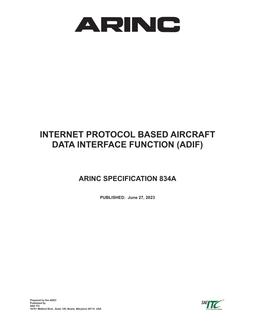-
-
Available Formats
- Availability
- Priced From ( in USD )
-
Available Formats
-
- Immediate download
- $154.00
- Add to Cart
-
- Printed Edition
- Ships in 1-2 business days
- $161.00
- Add to Cart
Customers Who Bought This Also Bought
-

ARINC 844P1
Priced From $350.00 -

ARINC 429P1-19
Priced From $380.00 -

ARINC 809-3
Priced From $245.00 -

ARINC 834A
Priced From $301.00
About This Item
Full Description
The purpose of this document is to provide equipment and aircraft manufacturers with guidance concerning the characteristics and utilization of aircraft electrical power. This material will cover, in addition to the description of basic power characteristics, detailed guidance setting forth the airline needs for transient protection, interference control, and basic design considerations for both equipment and installations
This document is intended to better acquaint the equipment designer with the electrical power systems employed in transport aircraft. A serious need for a better understanding of electrical power characteristics, and particularly its undesirable characteristics, has been evidenced by reoccurring equipment design deficiencies. Typical deficiencies in the airline equipment include inadequate supply voltage tolerance, susceptibility to the ripple content of DC power and, perhaps the most significant, the inability to survive voltage transients. Although many of these problems were well known or predicted by the aircraft electrical system designers, some equipment designers who are rather new to the commercial avionics field have all too frequently failed to recognize the existence of such basic problems. Although the old timers have learned the solutions to these problems the hard way after spending a lot of money in the redesign and modification of equipment which went into airline service, the wider and broader application of solid state electronic equipment to airline aircraft has brought a large number of manufacturers into the field and the airlines do not wish to serve as a proving ground while all these manufacturers learn the necessary design pitfalls.
At the same time there is a need to acquaint the airframe designer, particularly the electronic equipment installation designer, with the techniques employed by the knowledgeable equipment designer in reaching the inevitable engineering compromises required to optimize the equipment performance in the face of the known power system characteristics and limitations. This need is evidenced by the installation where suitably designed equipment fails to meet the operational needs of the customer as a consequence of an improper application.
We are all learning rapidly as the solid state equipment logs more and more hours; this document attempts to record for posterity the important points established thus far there will be more later.






